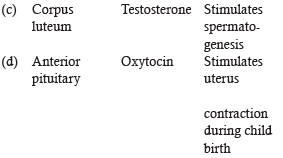31 Years NEET Previous Year Questions: Chemical Coordination & Regulation - 1 - NEET MCQ
24 Questions MCQ Test - 31 Years NEET Previous Year Questions: Chemical Coordination & Regulation - 1
Erythropoietin hormone which stimulates R.B.C. formation is produced by: [2021]
Select the correct statement. [2020]
How does steroid hormone influence the cellular activities? [2019]
Norepinephrine : [NEET Kar. 2013]
(1) Is released by sympathetic fibres
(2) Is released by parasympathetic fibres
(3) Increases the heart rate
(4) Decreases blood pressure
Which of the above said statements are correct?
Which of the following represents the action of insulin? [NEET Kar. 2013]
Select the answer which correctly matches the endocrine gland with the hormone it secrets and its function/deficiency symptom: [NEET 2013]


A pregnant female deliver a baby who suffers from stunted growth, mental retardation/low intelligence quotient and abnormal skin. This is the result of : [NEET 2013]
Which of the following statements is correct in relation to the endocrine system? [NEET 2013]
What is correct to say about the hormone action in humans [2012]
Which one of the following pairs of hormones are the examples of those that can easily pass through the cell membrane of the target cell and bind to a receptor inside it (Mostly in the nucleus) [2012]
The 24 hour (diurnal) rhythm of our body such as the sleep-wake cycle is regulated by the hormone : [2011M]
Given below is an incomplete table about certain hormones, their source glands and one major effect of each on the body in humans. Identify the correct option for the three blanks A, B and C. [2011]

Options :
Match the source gland with respective hormone as well as the function correctly. [2011]

Toxic agents present in food which interfere with thyroxine synthesis lead to the development of: [2010]
Which one of the following pairs is incorrectly matched? [2010]
Low Ca++ in the body fluid may be the cause of:[2010]
Injury to adrenal cortex is not likely to affect the secretion of which one of the following? [2010]
A health disorder that results from the deficiency of thyroxine in adults and characterised by (i) a low metabolic rate, (ii) increase in body weight and (iii) tendency to retain water in tissues is: [2009]
Which one of the following pairs of organs includes only the endocrine glands? [2008]
The blood calcium level is lowered by the deficiency of [2008]
Feeling the tremors of an earthquake a scared resident of seventh floor of a multistored building starts climbing down the stairs rapidly. Which hormone initiated this action ? [2007]
A person is having problems with calcium and phosphorus metabolism in his body. Which one of following glands may not be functioning properly ? [2007]
Which part of ovary in mammals acts as an endocrine gland after ovulation ? [2007]
Which one of the following statement is correct? [2006]














